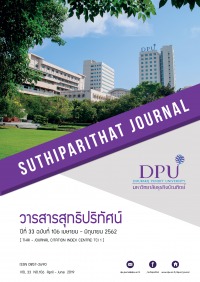การวัดมูลค่าและการกำหนดราคาโอนสินทรัพย์ไม่มีตัวตนในยุคเศรษฐกิจดิจิทัล
คำสำคัญ:
การวัดมูลค่าและการรับรู้รายการสินทรัพย์สินทรัพย์ไม่มีตัวตน, โครงการป้องกันการถูกกัดกร่อนฐานภาษีและการโอนกำไรไปต่างประเทศบทคัดย่อ
บทความวิชาการนี้มีวัตถุประสงค์เพื่อให้ผู้เสียภาษีไนประเทศไทยตระหนักถึงการรับรู้รายการ และการวัดมูลค่าสินทรัพย์ไม่มีตัวตน ซึ่งมีความสำคัญอย่างยิ่งในยุคเศรษฐกิจดิจิทัล โดยเฉพาะหลังจากประเทศไทยได้เข้าร่วมโครงการป้องกันการถูกกัดกร่อนฐานภาษีและการโอนกำไรไปต่างประเทศขององค์กรเพื่อความร่วมมือทางเศรษฐกิจและการพัฒนา ส่งผลให้มีแนวทางการรับรู้รายการและการวัดมูลค่าสินทรัพย์ไม่มีตัวตนมีแนวปฏิบัติที่ชัดเจนขึ้น และช่วยลดความเสียหายที่เกิดจากการหลีกเลี่ยงภาษีขององค์กรข้ามชาติผ่านสินทรัพย์ไม่มีตัวตน และการปฏิบัติตามแนวทางดังกล่าวช่วยให้หน่วยงานจัดเก็บภาษีภาครัฐของแต่ละประเทศใช้แนวทางเดียวกัน ช่วยลดข้อพิพาทกับหน่วยงานจัดเก็บภาษีของภาครัฐ ตลอดจนช่วยให้ข้อมูลที่เป็นประโยชน์ต่อนักลงทุน
นอกจากนี้ บทความนี้เสนอแนวทางสำหรับงานวิจัยในอนาคตเช่น ผลกระทบในประเทศไทยหลังจากเข้าร่วมโครงการป้องกันการถูกกัดกร่อนฐานภาษีและการโอนกำไรไปต่างประเทศดังกล่าว หรือศึกษาแนวทางการวัดมูลค่ายุติธรรมของสินทรัพย์ไม่มีตัวตนในโลกยุคดิจิทัล ตลอดจนศึกษาปัญหาหรือผลกระทบที่เกิดจากการประยุกต์ใช้การรับรู้รายการและการวัดมูลค่าตามแนวปฏิบัติของโครงการดังกล่าว
References
ตลาดหลักทรัพย์แห่งประเทศไทย. (2561). ข้อมูลรายบริษัท/หลักทรัพย์. สืบค้น 20 ตุลาคม 2561, จาก https://www.set.or.th/set/commonslookup.do?language=th&country=TH
สภาวิชาชีพบัญชี. (2561). มาตรฐานการบัญชี ฉบับที่ 38 (ปรับปรุง 2560) เรื่อง สินทรัพย์ไม่มีตัวตน. สืบค้น 5 ตุลาคม 2561, จาก http://www.fap.or.th/upload/9414/83W1d9vPQV.pdf
สภาวิชาชีพบัญชี. (2561). มาตรฐานการรายงานทางการเงิน ฉบับที่ 13 (ปรับปรุง 2560) เรื่อง การวัดมูลค่ายุติธรรม. สืบค้น 5 ตุลาคม 2561, จาก http://www.fap.or.th/upload/9414/PBixX8Z5bC.pdf
Barron, O. E., Chung, S. G., & Yong, K. O. (2016). The effect of statement of financial accounting standards No. 157 Fair Value Measurements on analysts’ information environment. Journal of Accounting and Public Policy, 35(4), 395-416.
Ishan, Z. M., & Noordin, N. (2015). Capitalising on income approach as trademark valuation for entrepreneurs. Pertanika Journal of Social Sciences & Humanities, 23, 147-160.
Kerschner, I., & Somare, M. (2017). Taxation in a global digital economy: Schriftenreihe IStR Band 107 (Vol. 107). Linde Verlag GmbH.
Lee, J. (2018, June 6). Bubble-like stock valuations miss $3.4 trillion in hidden assets. Bloomberg. Retrieved October 20, 2018, from https://www.bloomberg.com/news/articles/2018-06-06/what-s-a-stock-worth-in-new-economy-accounting-has-its-critics
Madhani, P. M. (2016). Corporate governance and disclosure practices of firms: the impact of nature and types of intellectual capital. The IUP Journal of Corporate Governance, 15(3), 7-35.
Neubig, T., & Wunsch-Vincent, S. (2018). Tax distortions in cross-border flows of intangible assets. International Journal of Innovation Studies, 2(3), 101-121.
OECD. (2014). Guidance on transfer pricing aspects of intangibles, OECD/G20 base erosion and profit shifting project. Paris: OECD Publishing.
Rudzika, K. (2018, March). DEMPE explained. Royalty Range. Retrieved October 20, 2018, from https://www.royaltyrange.com/home/blog/dempe-explained
Stathis K. L. (2015, May 3). Ocean tomo releases 2015 annual study of intangible asset market value. Oceantomo, Retrieved October 20, 2018, from https://www.oceantomo.com/blog/2015/03-05-ocean-tomo-2015-intangible-asset-market-value/
Transfer Pricing Asia. (2018). What is transfer pricing: A clear and simple definition. Retrieved October 20, 2018, from https://transferpricingasia.com/what-is-tp/
Downloads
เผยแพร่แล้ว
How to Cite
ฉบับ
บท
License
เนื้อหาและข้อมูลในบทความที่ลงตีพิมพ์ในวารสารสุทธิปริทัศน์ ถือเป็นข้อคิดเห็นและความรับผิดชอบของผู้เขียนบทความโดยตรงซึ่งกองบรรณาธิการวารสาร ไม่จำเป็นต้องเห็นด้วย หรือร่วมรับผิดชอบใดๆ
บทความ ข้อมูล เนื้อหา รูปภาพ ฯลฯ ที่ได้รับการตีพิมพ์ในวารสารสุทธิปริทัศน์ ถือเป็นลิขสิทธิ์ของวารสารสุทธิปริทัศน์หากบุคคลหรือหน่วยงานใดต้องการนำทั้งหมดหรือส่วนหนึ่งส่วนใดไปเผยแพร่ต่อหรือเพื่อกระทำการใด ๆ จะต้องได้รับอนุญาตเป็นลายลักษณ์อักษรจากวารสารสุทธิปริทัศน์ก่อนเท่านั้น






